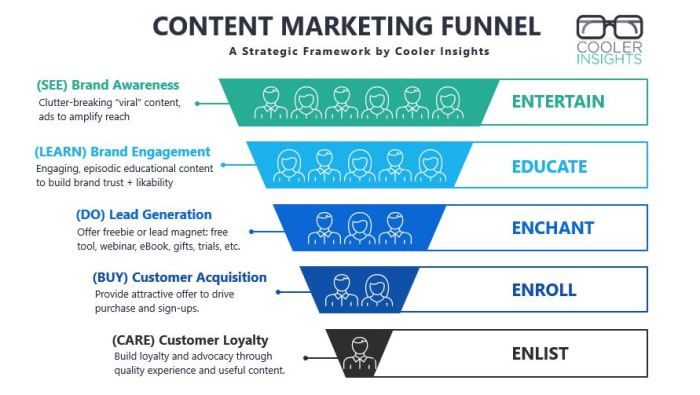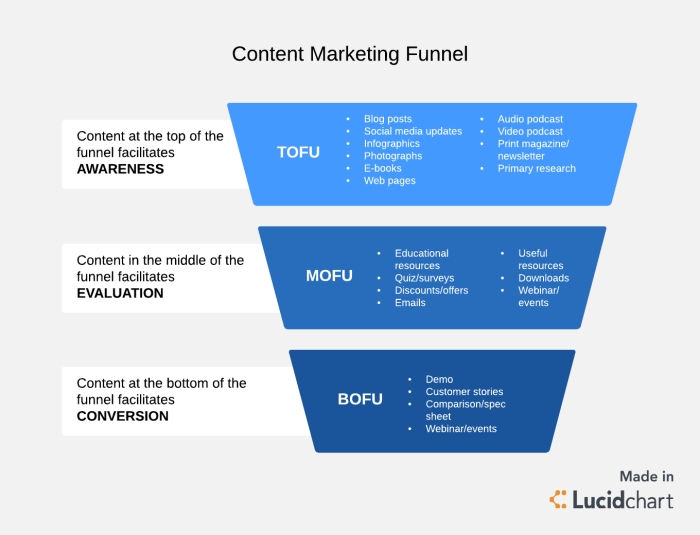Developing a Content Marketing Funnel sets the stage for a strategic approach to online promotion, diving deep into the key elements that drive successful campaigns. From defining the funnel stages to creating tailored content, this guide unveils the secrets to engaging your audience and boosting conversions with style.
As we explore the different facets of content marketing funnels, you’ll discover how each stage plays a crucial role in attracting, nurturing, and converting leads, ultimately leading to increased sales and brand growth.
Understanding the Content Marketing Funnel

To break it down, a content marketing funnel is a strategic approach to guide potential customers through various stages of the buying journey by providing them with valuable and relevant content.
Stages of a Content Marketing Funnel
- Awareness: This is the top of the funnel where the focus is on creating brand awareness and attracting a broad audience. Content at this stage should be engaging and informative to capture the attention of potential customers.
- Interest: In this stage, the goal is to nurture leads by providing more detailed content that addresses their specific needs and interests. This helps in building a relationship with the audience.
- Consideration: At this point, potential customers are evaluating different options and considering making a purchase. Content here should focus on highlighting the benefits of the product or service and addressing any concerns or objections.
- Decision: The final stage is where the potential customer makes a decision to purchase. Content here should include strong calls to action and incentives to encourage conversion.
Importance of a Content Marketing Funnele
Having a well-defined content marketing funnel is crucial in digital marketing strategies as it helps businesses effectively target and engage with their audience at each stage of the buying process. By delivering the right content to the right people at the right time, businesses can increase conversions, build brand loyalty, and drive revenue growth.
Top of the Funnel (TOFU) Content
When it comes to content marketing, the Top of the Funnel (TOFU) content plays a crucial role in attracting and engaging a wide audience. This initial stage of the content marketing funnel aims to create awareness and generate interest in your brand, products, or services.
Purpose of TOFU Content
TOFU content is designed to cast a wide net and appeal to a broad audience that may not be familiar with your brand yet. It focuses on providing valuable and educational information to capture the attention of potential customers and establish your brand as a thought leader in your industry.
Yo, have you heard about the power of Using Social Media Analytics for Strategy? It’s like having a secret weapon to boost your online game! By analyzing data from social media platforms, you can make informed decisions to level up your marketing strategy. Check out this dope article on Using Social Media Analytics for Strategy for some major insights!
- Blog Posts: Informative articles that address common pain points or questions your target audience may have.
- Social Media Posts: Engaging posts on platforms like Facebook, Instagram, and Twitter to increase brand visibility and drive traffic to your website.
- Infographics: Visual representations of data or information to make complex concepts easier to understand and share.
TOFU content acts as the first touchpoint for potential customers, piquing their interest and guiding them further down the marketing funnel.
How TOFU Content Helps Attract and Engage a Broad Audience
TOFU content helps attract a broad audience by providing valuable information that addresses their needs and interests. By creating content that resonates with a wide range of individuals, you can increase brand awareness and reach a larger pool of potential customers. Additionally, TOFU content encourages engagement through likes, shares, and comments, allowing you to interact with your audience and build relationships that can lead to future conversions.
Middle of the Funnel (MOFU) Content
MOFU content plays a crucial role in the content marketing funnel by engaging leads who have already shown interest in your brand or products/services. It aims to provide valuable information to educate and build trust with potential customers, ultimately moving them closer to making a purchase decision.
Examples of MOFU Content
MOFU content can come in various forms, such as:
- Case studies showcasing success stories and real-world applications of your products/services.
- Whitepapers offering in-depth analysis, research, and insights on industry trends or specific topics related to your offerings.
- Webinars providing interactive sessions where leads can learn more about your products/services and ask questions in real-time.
How MOFU Content Nurtures Leads
MOFU content nurtures leads by providing them with valuable and relevant information that addresses their specific needs and pain points. By offering in-depth insights, case studies, or interactive experiences, MOFU content helps build credibility and trust with leads, positioning your brand as a reliable source of information. This, in turn, moves leads closer to conversion by guiding them through the decision-making process and showcasing the value of your offerings.
Bottom of the Funnel (BOFU) Content

When it comes to the content marketing funnel, the Bottom of the Funnel (BOFU) content plays a crucial role in converting leads into customers. This is where potential customers are at the final stage of the buyer’s journey, ready to make a purchase decision.
BOFU content is designed to provide detailed information about the products or services offered, addressing any specific concerns or objections that the potential customer may have. It aims to convince the lead that the product or service being offered is the best solution to their problem.
Yo, check it out, fam! If you’re tryna step up your game and boost your biz strategy, you gotta get on that social media analytics grind, ya feel me? Hit up this dope link on Using Social Media Analytics for Strategy to learn how to level up your game and stay ahead of the curve.
Examples of BOFU Content
- Product Demos: Showing the product in action to demonstrate its features and benefits.
- Free Trials: Allowing potential customers to try out the product or service before committing to a purchase.
- Consultations: Offering personalized consultations to address specific needs and questions.
How BOFU Content Drives Conversions and Sales
BOFU content helps drive conversions and sales by providing potential customers with the information they need to make a confident purchase decision. By addressing their specific needs and concerns, BOFU content builds trust and credibility, making the customer more likely to convert.
Additionally, BOFU content helps to showcase the value of the product or service, highlighting its unique selling points and competitive advantages. This can sway potential customers who are on the fence about making a purchase, ultimately leading to increased sales and revenue for the business.
Creating a Content Strategy for Each Funnel Stage: Developing A Content Marketing Funnel
Developing a successful content marketing funnel requires a well-thought-out strategy tailored to each stage of the funnel. It’s crucial to understand the unique needs and interests of users at different stages and deliver content that resonates with them effectively.
Tips for Developing Tailored Content
- Identify the specific goals and pain points of users at each stage of the funnel.
- Create content that addresses these goals and pain points effectively.
- Utilize different content formats such as blog posts, videos, infographics, and case studies to engage users at various funnel stages.
- Personalize your content to make it more relevant and engaging to users.
- Use targeted s and phrases to attract users searching for solutions related to their current stage in the funnel.
Aligning Content with User Needs, Developing a Content Marketing Funnel
It’s essential to align your content with the needs and interests of users at different funnel stages to guide them smoothly through the buyer’s journey. By understanding their motivations, challenges, and preferences, you can create content that speaks directly to them and moves them closer to conversion.
Importance of Consistency and Relevance
Consistency in messaging and relevance of content throughout the funnel are key to maintaining user engagement and trust. Ensure that your content flows seamlessly from one stage to the next, providing valuable information and guiding users towards making informed decisions. By keeping your content consistent and relevant, you build credibility and authority with your audience, increasing the likelihood of conversion.
Analyzing and Optimizing the Content Marketing Funnel
When it comes to analyzing and optimizing the content marketing funnel, it’s essential to track the effectiveness of your content at different stages of the funnel. This allows you to understand what’s working well and where improvements can be made to drive better results.
Methods for Analyzing the Effectiveness of Content
- Use analytics tools: Utilize tools like Google Analytics to track key metrics such as traffic, engagement, and conversions at each funnel stage.
- A/B testing: Experiment with different types of content to see which resonates best with your audience and drives the desired actions.
- Customer feedback: Gather insights from surveys, reviews, and social media to understand how your content is perceived and where it can be enhanced.
Ways to Optimize the Content Marketing Funnel
- Personalization: Tailor your content to meet the specific needs and preferences of your target audience at each funnel stage.
- Optimize CTAs: Ensure that your calls-to-action are clear, compelling, and aligned with the goals of each funnel stage to drive conversions.
- Content alignment: Make sure that the content you deliver at each stage of the funnel is cohesive and guides leads seamlessly towards making a purchase decision.
Importance of Continuous Monitoring and Refinement
- Adapt to trends: Stay updated on industry trends and consumer behavior to adjust your content strategy accordingly for optimal results.
- Iterative improvement: Continuously analyze data and feedback to refine your content marketing funnel over time and maximize its effectiveness.
- Stay agile: Be prepared to make quick adjustments to your content strategy based on real-time insights to stay competitive in the market.
